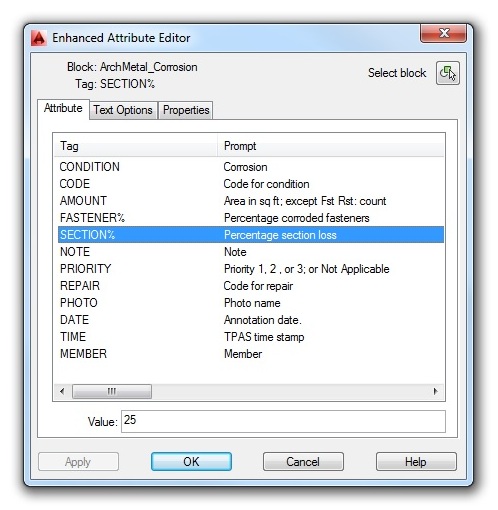Options for block customization in TPAS are virtually endless. Recent TPAS projects have involved adding custom parameters to an existing condition survey block library, creating custom blocks in order to hyperlink non-jpeg data file types to the drawing, and building complex custom blocks for an in-depth survey and characterization of windows and doors. Let’s take a look at each case in more detail.

Steel trusses comprising a dam flood gate – the subject of a recent inspection using TPAS
The client for a dam floodgate investigation required data on the condition of individual steel truss members. An existing block library for surveying the condition of structural metals included blocks to record corrosion, deformation, cracking and other conditions. Building on this existing library, additional data inputs were added to each block so that surveyors could record the member type, additional notes, and percentage of section loss or failed fasteners, where applicable. In addition, a new block was created to record instances of leaking seals at the sides of the floodgates.

Annotated TPAS drawing of a flood gate truss

Information captured in custom TPAS blocks included percentage of corroded fasteners, section loss due to corrosion, and member type
Adding or removing fields and changing text display options can all be done in the source .dwg file of the blocks, as demonstrated in this video clip. This is a great option for quickly creating customized blocks based on an existing block library.
Sometimes, entirely new blocks are called for. For example, during a building investigation involving the use of ground-penetrating radar (GPR), custom blocks were created to record surveryors’ observations and to hyperlink the GPR data files. Simple blocks such as these can be built quickly within AutoCAD, as in the above example.
For creating complex blocks, or making batch changes to a library of blocks, AutoLISP (a simple list-processor programming language) can be a time-saving tool. For a survey of a large group of historic buildings, custom blocks were built from scratch using LISP routines, in order to capture highly detailed information on windows and doors. This approach essentially transforms a paper-and-pen survey form into a digital record complete with photographs keyed to an exact location on the drawing.

Custom block for surveying door hardware throughout a complex of historic buildings
These examples are just the beginning of the endless options for customization in TPAS. Please post in the comments below or contact Kelly if you have questions about block customization.
